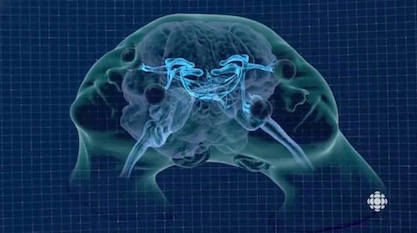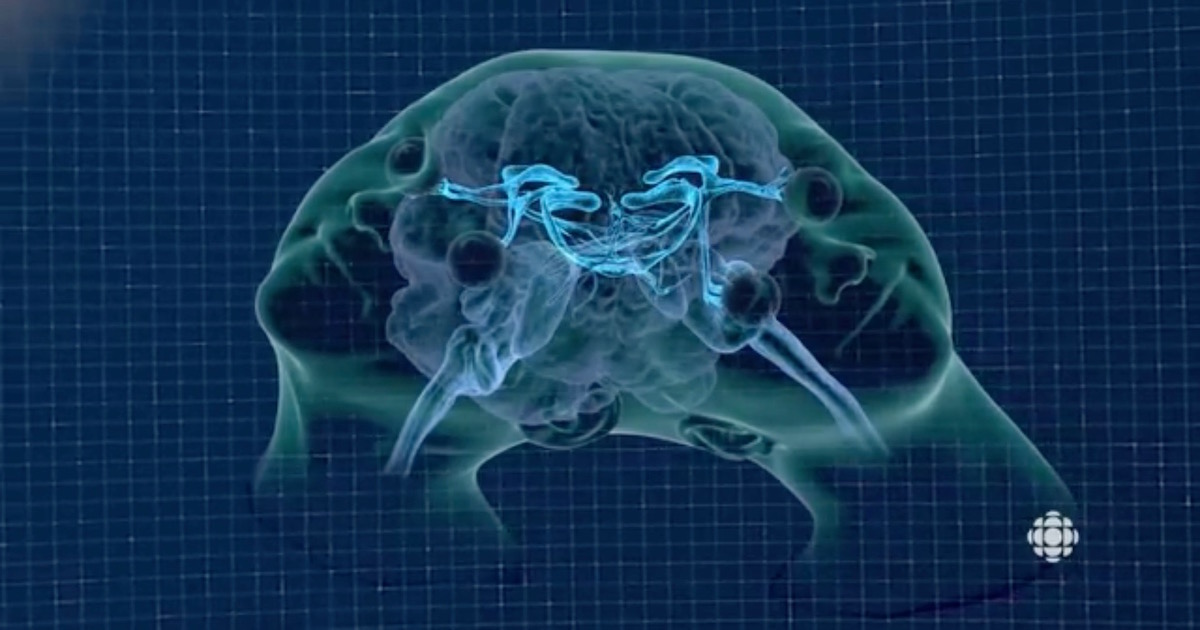 Medicine
Medicine
 Neuroscience & Mind
Neuroscience & Mind
What the Craniopagus Twins Teach Us About the Mind and the Brain


My colleagues David Klinghoffer and Denyse O’Leary have superb posts about Krista and Tatiana Hogan, who are conjoined twins who share connections between their brains. The twins are the subject of two CBC TV documentaries, telling their remarkable stories at, respectively, ages seven and eleven. They have much to teach us about the relationship between the brain and the mind.
The twins share portions of their brains and a common blood flow to their brains. They can never be safely surgically separated. The most important brain structure that they share is a thalamic bridge, which is a bundle of nerve axons. A similar connection exists in all people, and it connects the two sides of the thalamus. The thalamus is a critical part of the brain that mediates wakefulness and motor and sensory function.
Because the girls have a common thalamic bridge, they share control and sensation in several of their limbs. Krista has sensation and motor control over both of her own legs, and sensation and control of Tatiana’s left leg. Tatiana has sensation and motor control over both of her own arms, and sensation and control of Krista’s right arm. It appears that the common control over their arms and legs is restricted to automatic unconscious movements, not to deliberate planned movement.
In addition, the girls share some aspects of vision from each other’s eyes as well as taste. It also appears that the girls share some thoughts: they will laugh at things together without speaking, as if they have the same thought in their minds.
What does this teach us about the relationship between the mind and the brain? It is essential that we understand what they share, and what they don’t share.
They are two people. They remain completely distinct children — they have, we might say, two separate souls, not one soul with two bodies. They remain different and fully distinct people. In fact, their story wouldn’t be so remarkable if they were one person, because centralized sensation and control of limbs is normal for one person, but quite remarkable for two people.
It is important to understand the aspects of mind that they do share. They share some motor control, some common sensations, and probably share some aspects of imagination — that is, the ability to reconstruct sensory images (visual, auditory, olfactory, etc.).
This sharing of some aspects of the mind, but not others, is remarkably consistent with classical Thomistic dualism. In Thomistic dualism, the human soul is the composite of three powers: vegetative, sensory, and rational. Vegetative powers are what we today call autonomic physiological control — control of heart rate, control of blood pressure, control of growth, reproduction, respiration, hormonal control, etc. These are unconscious powers that make life possible in the most fundamental way.
We also have “sensory” powers, which include (in modern terminology) sensation as well as motor function, and imagination and emotion. These vegetative and sensory powers of the mind are common to those of plants and animals, who have physiological (plants) and motor and sensory (animals) powers akin to those of humans.
Human beings alone have rational powers, which is the ability to think abstractly, without reference to particular things. Abstract mathematics, and abstract thought about logic or morality, are examples of rational powers of the human soul that are not shared by plants or animals.
Vegetative and sensory powers of the soul are material powers. They are tightly linked to brain function and are wholly the result of physical processes. However, rational powers of the soul — abstract thought — are immaterial powers. They are not caused by matter, although material processes, such as wakefulness, normal physiology, vision, imagination, etc., are necessary for normal expression of immaterial abstract thought. In the Thomistic understanding, material powers “present” information to the immaterial rational aspect of the soul, which abstracts the intelligible species (immaterial form) from the matter and comprehends it.
In light of this Thomistic understanding of the soul, the abilities that Tatiana and Krista share are the material powers of the brain, which we expect them to share, because they share brain matter. What they don’t appear to share is the immaterial aspect of the soul — reasoning in an abstract sense, and personal identity, individuality, etc. They are separate souls who share some material brain tissue, and thus share some material powers of the mind. They do not share immaterial powers of the mind, because immaterial powers can’t be shared, because immaterial powers aren’t material things that can be common to two people.
Neuroscience Confirms Thomistic Dualism
Tatiana’s and Krista’s shared and individual powers of mind are just what Thomistic dualism predicts. They share material powers of mind, but not immaterial powers. They remain distinct souls.
This distinction between material and immaterial powers of the mind has been observed in other aspects of neuroscience. Roger Sperry’s Nobel Prize-winning studies of split brain operations showed that what was “split” by surgically dividing the brain in half were sensory powers of the mind. A patient with a split brain remains a discrete individual person, with one self and one mind. It is the perceptual and sensory aspect of the mind that splits with surgical cutting of the corpus callosum. The person remains unitary.
A similar phenomenon was noted by Wilder Penfield, who was the pioneering neurosurgeon who started the discipline of epilepsy surgery. He noted that while operating on conscious patients he could stimulate many sensory and motor aspects of brain function, but he couldn’t stimulate or ablate that patient’s sense of self or experience of unitary existence. There was, Penfield noted, as aspect of the mind that he couldn’t reach, that remained beyond his surgical instruments. This has certainly been my experience as a neurosurgeon as well.
Neuroscientist Benjamin Libet, who pioneered the scientific study of consciousness and of free will, also found an immaterial power of the mind that appears distinct from and prior to material mental powers. He concluded that free will is real, and that while our actions seem to be motivated by unconscious intentions, we retain the immaterial ability to veto our actions in accordance with moral law.
It is worth noting that the conclusion that the human mind has material and immaterial powers is well founded in theology, philosophy, and neuroscience. The evidence for dualism, and specifically for Thomistic dualism, is abundant in neuroscience. We are composites of material powers and immaterial powers. In the traditional way of understanding man, we are composites of matter and spirit, and we bridge the gap between the two realms of nature.
Image: Screengrab from “Twin Life: Sharing Mind and Body,” via CBC TV/YouTube.
